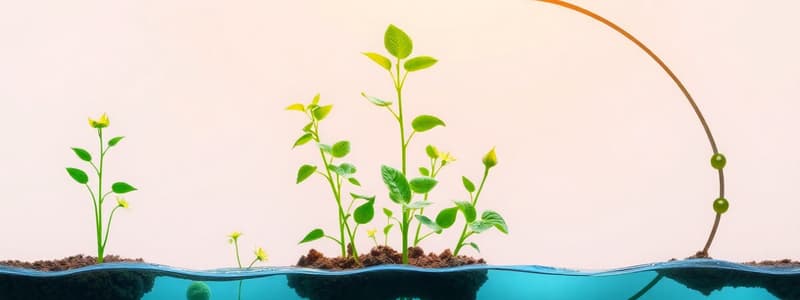Podcast
Questions and Answers
Which of the following is the MOST accurate description of how energy flows through an ecosystem, starting with the sun?
Which of the following is the MOST accurate description of how energy flows through an ecosystem, starting with the sun?
- The sun provides energy for animals, which then provide energy for plants through decomposition.
- The sun's energy is converted into chemical energy by plants, which is then consumed by other organisms. (correct)
- The sun heats the Earth, providing warmth directly to all living organisms.
- The sun's photons directly fuel the growth of all organisms, bypassing the need for intermediary processes.
If a forest ecosystem experiences a prolonged drought leading to widespread plant death, which of the following long-term consequences is MOST likely?
If a forest ecosystem experiences a prolonged drought leading to widespread plant death, which of the following long-term consequences is MOST likely?
- An immediate increase in atmospheric nitrogen levels due to decreased plant absorption.
- An increase in the rate of photosynthesis among the remaining plants, compensating for the loss.
- A significant short-term decrease in the availability of carbon for other organisms. (correct)
- A rapid increase in the population of herbivores due to the abundance of dead plant matter.
How does the decomposition of organic matter contribute to the sustainability of an ecosystem?
How does the decomposition of organic matter contribute to the sustainability of an ecosystem?
- By releasing essential elements like carbon, nitrogen, and phosphorus back into the environment. (correct)
- By creating new organic compounds that are immediately available for consumption.
- By permanently storing carbon, nitrogen, and phosphorus, preventing their loss from the ecosystem.
- By converting solar energy directly into usable energy for plants.
Why is nitrogen fixation an essential process in the nitrogen cycle?
Why is nitrogen fixation an essential process in the nitrogen cycle?
If a scientist discovers a new organism that does not require carbon, nitrogen, phosphorus, or water, what implication would this have on our current understanding of life?
If a scientist discovers a new organism that does not require carbon, nitrogen, phosphorus, or water, what implication would this have on our current understanding of life?
Flashcards
Photosynthesis
Photosynthesis
The process of converting sunlight into usable chemical energy (food) for plants.
Carbon
Carbon
An element crucial for building all organic material like carbohydrates, lipids, proteins, and nucleic acids.
Nitrogen
Nitrogen
An element primarily sourced from the atmosphere, essential in building proteins and nucleic acids (DNA).
Phosphorus
Phosphorus
Signup and view all the flashcards
Water
Water
Signup and view all the flashcards
Study Notes
- Existence on Earth depends almost entirely on the sun.
- The sun sends photons to Earth which drive photosynthesis.
- Photosynthesis is the process of converting sunlight into usable, chemical energy.
- All organisms need free energy and matter to live.
- Living organisms must regularly exchange free energy and matter with their environment.
- Molecules and atoms in the environment are used to create new ones.
- When organisms die, their bodies break down and feed new plants and animals.
Key Elements for Life
- Carbon is crucial because it forms the basis for all organic material including:
- Carbohydrates
- Lipids
- Proteins
- Nucleic acids
- Nitrogen is also important and makes up 79% of Earth's atmosphere.
- Nitrogen builds proteins and nucleic acids, which make up DNA.
- Phosphorous is a key component of DNA.
- Phosphorous is essential for cell division and growth.
- Water is essential for life.
- Water helps blood flow, cells divide, and organs function.
Energy Capture and Storage
- Cycling energy and matter means there is no loss on Earth.
- Energy is temporarily stored in living organisms to drive biological processes.
- Plants are autotrophs and make their own food through photosynthesis.
- Autotrophs are self-feeders.
- Humans are heterotrophs and depend on organisms for food.
- Heterotrophs are other-feeders
- Cellular respiration harvests energy by breaking down carbohydrates.
- Glycolysis and the Krebs cycle turn sugar molecules into ATP.
- ATP is an essential molecule for life.
- Organisms use free energy for growth and reproduction.
- Body temperature and metabolism rely on free energy intake.
- Reproduction requires energy, such as birds feeding their young.
- Hibernating animals store energy to survive without eating for months.
Changes in Free Energy
- Changes in available free energy affect organisms and ecosystems.
- Lack of free energy leads to hunger and wasting away.
- Excess free energy leads to storage and growth.
- Removing producers from an ecosystem or decreasing sunlight reduces usable energy.
- Organisms dependent on producers may die without usable energy.
- Changes in one trophic level can drastically affect the rest.
Studying That Suits You
Use AI to generate personalized quizzes and flashcards to suit your learning preferences.




